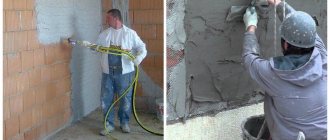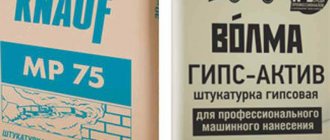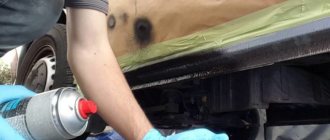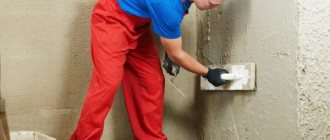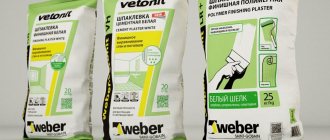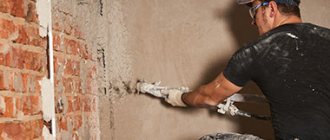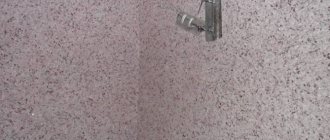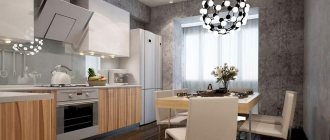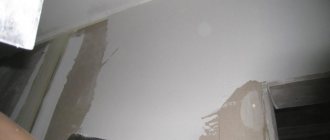When finishing walls with plaster, mechanical and manual methods are used. Applying the plaster mixture by machine allows you to reduce work time, the coating is dense and of high quality. However, it must be taken into account that the technology is designed for large areas; when processing compact rooms, you can use the manual method.
The essence of machine plaster
The technology of mechanized plaster involves applying a solution under strong pressure from a specialized unit onto a cleaned and primed surface.
Mechanized technology is used for cosmetic repairs and capital construction. The work uses special pneumatic devices that are characterized by high productivity and a reduction in the volume of plaster mortar waste.
The devices are easy to use. The equipment contains a compressor, connecting elements, hoses, mixing containers, etc. When working with mechanized devices, special plaster is used. After setting up the equipment, the construction mixture is poured into the receiving hopper, and in the process it is combined with water to prepare the solution.
Machine plastering is carried out in compliance with the following steps:
- Prepare the surface, clean it from dust, prime it, rub the walls to increase adhesion.
- If there are cracks, putty will be required; the composition will eliminate cracks and unevenness on the surface.
- For even application of the plaster composition, special beacons are set.
- At the next stage, the plaster composition is prepared, the dry material is poured into the unit, in which the mass is mixed with water until a homogeneous consistency.
- By spraying, the plaster solution is applied to the prepared panels. The sprayer must be held at right angles to the surface.
- Using the rule, the plastered surface is leveled.
- Hard-to-reach areas are treated with a solution using a spatula and trowel. Joints and corner areas are finished by hand.
- After the plaster solution has hardened, after 2-2.5 hours, the panels are grouted to eliminate small irregularities and make the surface smooth.
- After the finish has dried, the coating is finished.
- The surface is finally cleaned of dust, the unit is disassembled and dried.
Leading equipment manufacturers and their products
PFT. A German manufacturer of plastering stations, whose products have proven themselves well on the market. The most successful models include PFT G4 Smart and RITMO XL (a new series of equipment). Despite the fact that the performance of comparable models of both series is practically the same, the PFT series stations are almost twice as large. The equipment operates from both single-phase and three-phase networks; there are also multi-voltage models (220V/380V). Almost all reviews of this manufacturer’s products are positive, so if the high price doesn’t bother you, then it’s better to buy them. Price range 250-300 thousand rubles.
PFT G4 Smart PHOTO: c.allegroimg.com
Putzmeister. Another German manufacturer that has been producing construction equipment, including plastering stations, since 1958. In terms of functionality and cost, its models are practically no different from the PFT series.
Putzmeister plastering station model MP 25 PHOTO: solatrade.ru
NOVO. The company's headquarters are registered in Germany, production facilities are in China. Despite this, the products are distinguished by their reliability and high performance. Price range 200-250 thousand rubles. In addition, there are additional advantages in the design:
- Possibility to connect an external compressor with a receiver;
- Water cooling of equipment.
Complete set of NOVO Gen3 PHOTO: novo.com.ru
Typhoon. Plastering station from the domestic manufacturer of the same name from Stavropol. The equipment is an extremely simplified and extremely unsuccessful replica of the PFT Ritmo L-L4-2. Among the main disadvantages, users name:
- Lack of electric motor power - it costs 1.5 kW, you need at least 2.2 kW;
- A compressor without a receiver fails after a week of operation;
- Leaky bunker welds - constantly leaking;
- Low-performance screw pair - in fact, this unit is not produced independently, but is purchased from the PFT company from the Ritmo L-L4-2 model.
Plaster station Typhoon PHOTO: i.ytimg.com
Other domestically produced plastering stations that can be found on the equipment market: Meteor, VEK, TSM 2, Hermes are even less successful copies of Typhoon.
Gallery: manual means of small-scale mechanization for applying plaster mixtures:
PHOTO: myshtukaturka.ru
PHOTO: i.ytimg.com
PHOTO: otdelka-expert.ru
PHOTO: couo.ru
Advantages and disadvantages of machine plaster
According to reviews, mechanical plaster has some advantages.
Among them are the following:
- means for plastering with aggregates are low in cost;
- the consumption of plaster mortar is reduced;
- reduced dust formation in the room;
- the plaster applied under strong pressure lays down in a dense layer;
- the adhesion parameters of the plaster to the base increase when using the unit;
- when applied by a mechanism, the porosity of the plaster increases, which increases the heat-shielding characteristics of the room;
- reducing the possibility of shrinkage of the plaster layer;
- increasing the strength and durability of the plaster layer;
- irregularities on the surface are filled in qualitatively, which improves its characteristics;
- the likelihood of cracks and chips is reduced.
The list of disadvantages of the technology includes the following:
- the work uses expensive units, you will need to pay for the labor of specialists;
- energy consumption increases;
- some machines are designed for three-phase connection, so use in residential areas is limited;
- work on applying machine plaster in residential premises is carried out only during the daytime due to the noise of the units;
- the technology is not used for curved surfaces (columns, arches);
- the unit requires maintenance and cleaning during operation;
- using a compressor requires additional space;
- large mass of the unit with a filled tank;
- a set of technical devices is highly expensive.
Basic technological secrets
Mechanized plaster has several technologies:
- 1. Simplified movement and maneuverability on site, regardless of volume.
- 2. Easy and simple assembly of all parts allows you to start working immediately after delivery.
3. The formation of dust and cement impurities in the air is eliminated, since mixing occurs in a tightly closed container.- 4. Saturation of the solution with air improves the quality and plastic properties of the solution.
- 5. The low specific gravity of impurities has a positive effect on the composition of the mixture.
- 6. Machine plastering of walls is carried out using dry or liquid material, which is the main difference.
- 7. Possessing thermal insulation and fire resistance, the use of required environmentally friendly finishes in the premises is allowed.
- 8. The price on the construction market is acceptable and affordable.
The formula for automatic processing includes:
- Mineral type additives;
- Special building modifiers;
- Gypsum mixes and their analogues.
Manual plastering: advantages and disadvantages
Applying plaster manually requires careful processing of the base, preparation of the mixture using a construction mixer, and installation of beacons. After the preparatory stage, the plaster solution is applied in 1-3 layers, after drying, grouting, sealing of beacon grooves, puttying and drying the surface with a hairdryer are performed.
The advantages of the manual method are as follows:
- work can be carried out without prior preparation;
- there will be no need to spend on expensive equipment;
- repairs can be carried out in stages;
- work is organized at a convenient time, because silent technology;
- plastering of complex and hard-to-reach areas, as well as curved bases, is available;
- each stage can be controlled, the number of layers and drying rate can be adjusted;
- you can select the ingredients for the plaster yourself;
- the composition can be prepared in small batches;
- It is possible to perform complex textured finishing techniques with a combination of layers of different shades and engraving.
The list of disadvantages of hand plastering includes the following:
- labor intensity of work, physical activity increases;
- the method is difficult to implement over large areas;
- plaster consumption increases;
- For some techniques, you will need to prepare 3 types of solutions (for spraying the surface, applying the base layer and finishing);
- low productivity.
What is better to choose
When deciding which plaster is better - manual or mechanized, the following factors are taken into account:
- The quality of the plaster mortar for machine finishing is high, the consistency is uniform. The quality of applying plaster manually depends on the skill of the specialist and may be inferior to machine finishing.
- The consumption of plaster composition when using the unit is lower. For manual equipment, the amount of material consumed depends on the application method and the skill of the specialist.
- When choosing a mechanized method, the area to be treated with plaster and the possibility of placing equipment are taken into account. In compact rooms, large units are not used, so the manual plastering method is recommended.
- For the machine method there are no restrictions on the temperature in the apartment or in other rooms. The manual method is not used at sub-zero air temperatures.
- For spacious rooms, experts recommend choosing the machine method due to the reduction in processing time. The manual technique is effective in small spaces. When processing large areas, labor productivity decreases.
Choosing between them
Since each method has its own advantages and disadvantages, choose between them depending on how much area needs to be processed and what is available for this. Typically for rooms of 200 square meters. m and more are already purchasing special equipment, because then the costs will be recouped thanks to faster work. In addition, it is worth considering that the result obtained largely depends on the qualifications of the person, so it is worth realistically assessing your strengths.
Tyutyunnikov Dmitry
Article verified by a decorative finishing specialist
Which is cheaper?
The choice of mechanized or manual plastering of walls is determined by the cost of work and finishing materials. In order to estimate the cost, you will need to calculate the area, quantity of material and its price. According to experts, the profitability of the mechanical method depends on the area of plastering. For large spaces, it is more effective and cost effective to order machine processing due to the savings in finishing materials and the cost of worker labor.
It is estimated that the price benefit from the mechanical method is achieved when processing an area of more than 150-200 m². With the manual method, plastering costs about 300 rubles. for an area of 1 m², with mechanized technology - from 250 rubles. for 1 m². However, it must be taken into account that these prices are announced by builders for large areas. For processing an apartment, mechanical work per 1 m² can be rated higher. The machine method is not used in finishing bathrooms and bathrooms.
The prices do not include the price of electricity, which will be required for machine finishing. The price of plaster for the machine method is reduced by 15-20% in comparison with compositions for the manual finishing method.
Therefore, for processing large areas, the use of technology will pay off. When finishing an apartment with a plastering area of about 90-100 m², the cost of mechanical application will be higher than manual labor.
Technology comparisons
Even builders do not have a consensus on which plastering method is best to choose, since each of them has pros and cons.
The manual method is considered traditional; it uses standard materials and tools. Special devices are not needed here, so even a person without highly specialized skills can plaster the walls.
For mechanized plastering, you will have to operate a special machine. The master pours dry mortar into it and it undergoes additional processing, thanks to which the remaining large particles are ground, which in most cases is better for the surface of the walls.
Can machine plaster be applied by hand?
Machine plastering of wall panels is carried out with specialized compounds that cost 20-30% less than standard ones. However, the use of mixtures for manual finishing is recommended taking into account the characteristics of the compositions. When adding water, it is difficult to estimate the proportions of liquid and powder. When switching to a machine composition, the hardening time may change, and the plasticity of the solution differs. You will need to master the use of this composition while maintaining the quality of the coating.
Therefore, experts recommend using compositions for manual plaster application techniques for the purpose of durability and high-quality finishing. To reproduce some artistic coatings (artificial aging, painting, multi-color surfaces), only specialized mixtures for manual work are used.
It is not recommended to use machine-made plaster compositions of untested quality. It is unacceptable to use mixtures that have expired, because A high-quality coating will not last long. The plaster layer may crack and lose its aesthetics.
It is best to consult a specialist when selecting plaster mixtures.
The choice is determined by the surface material (concrete base, brickwork, plasterboard floors), the size of the room, temperature conditions during operation, the design solution required for the architectural project, and the color scheme.
